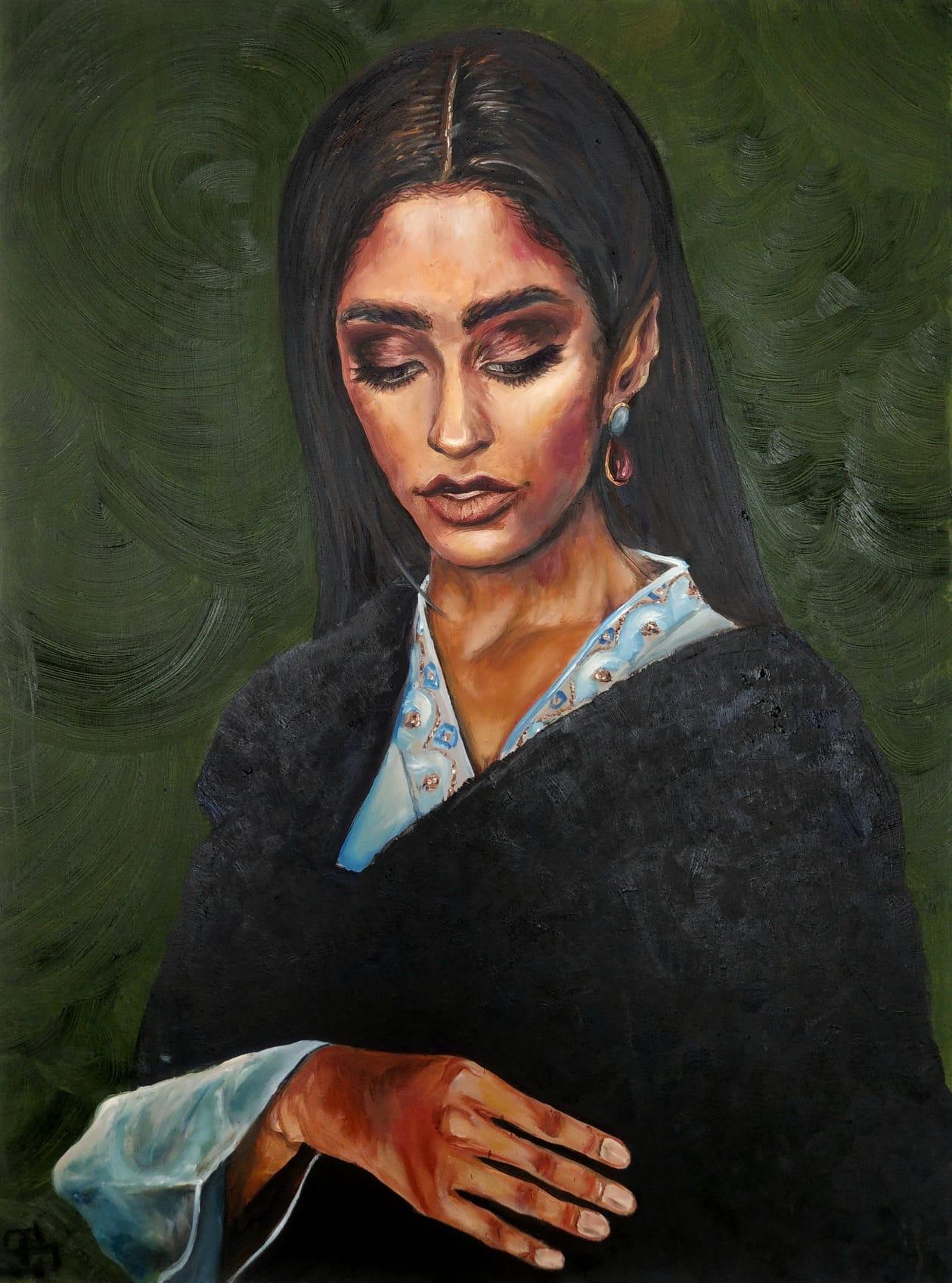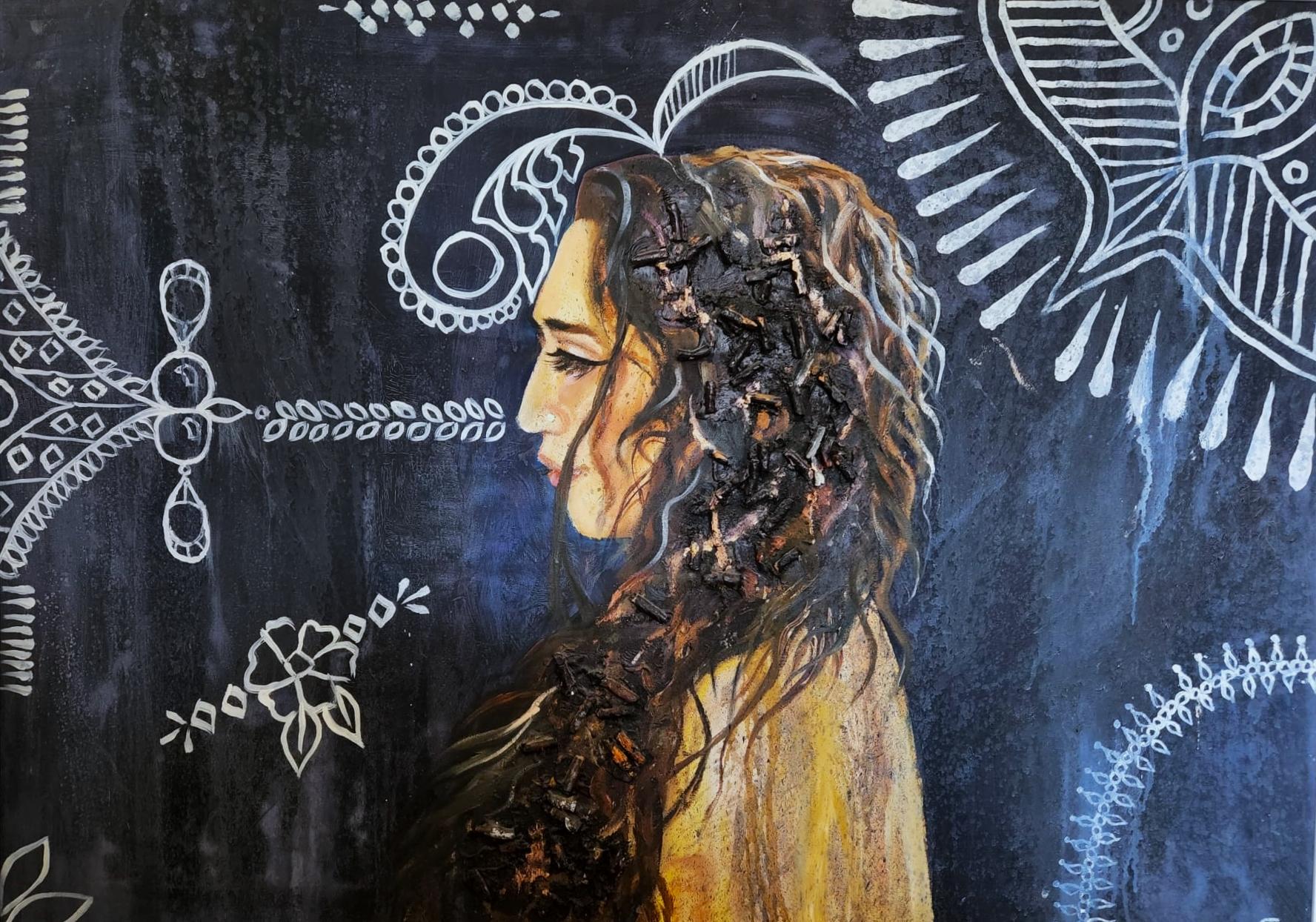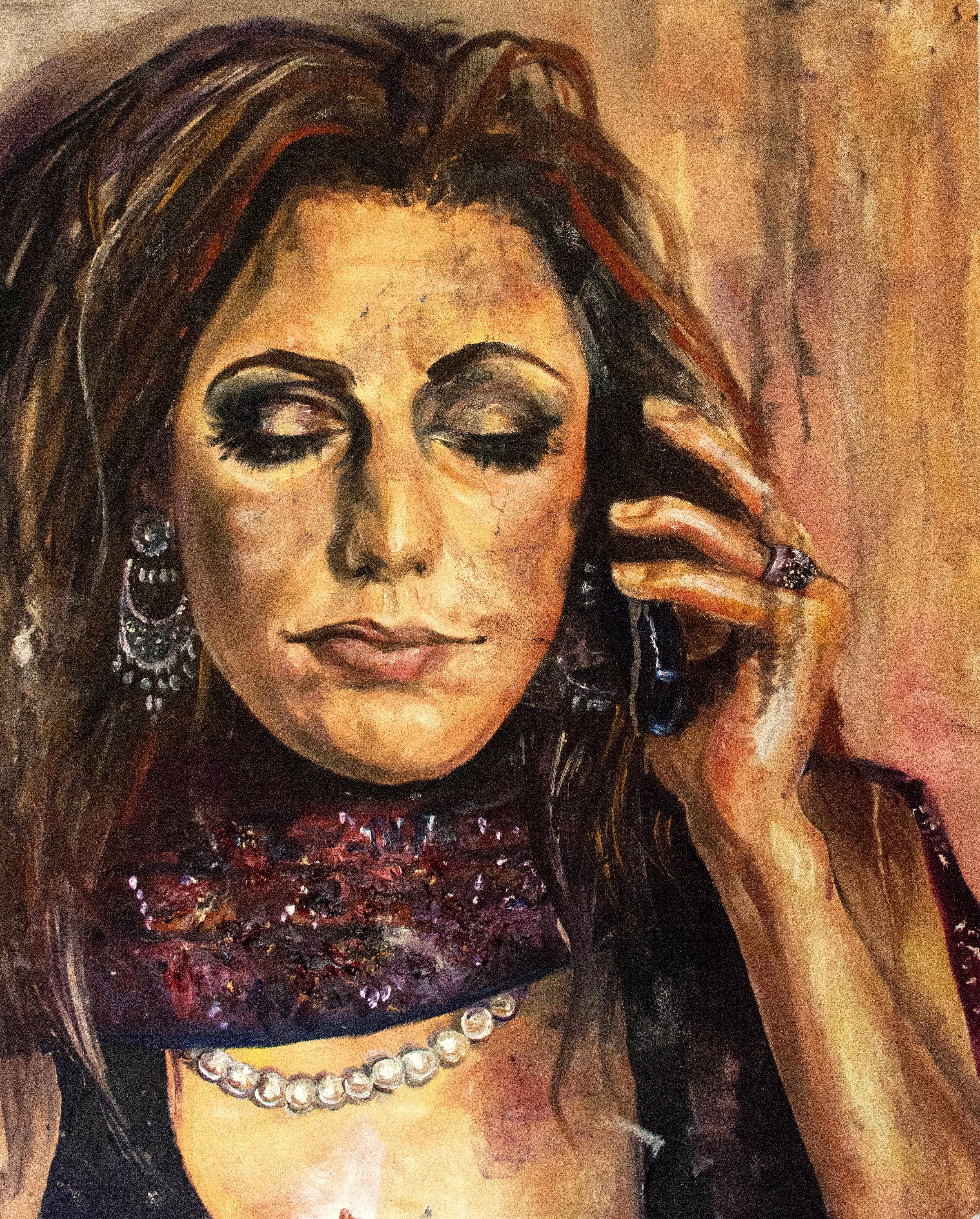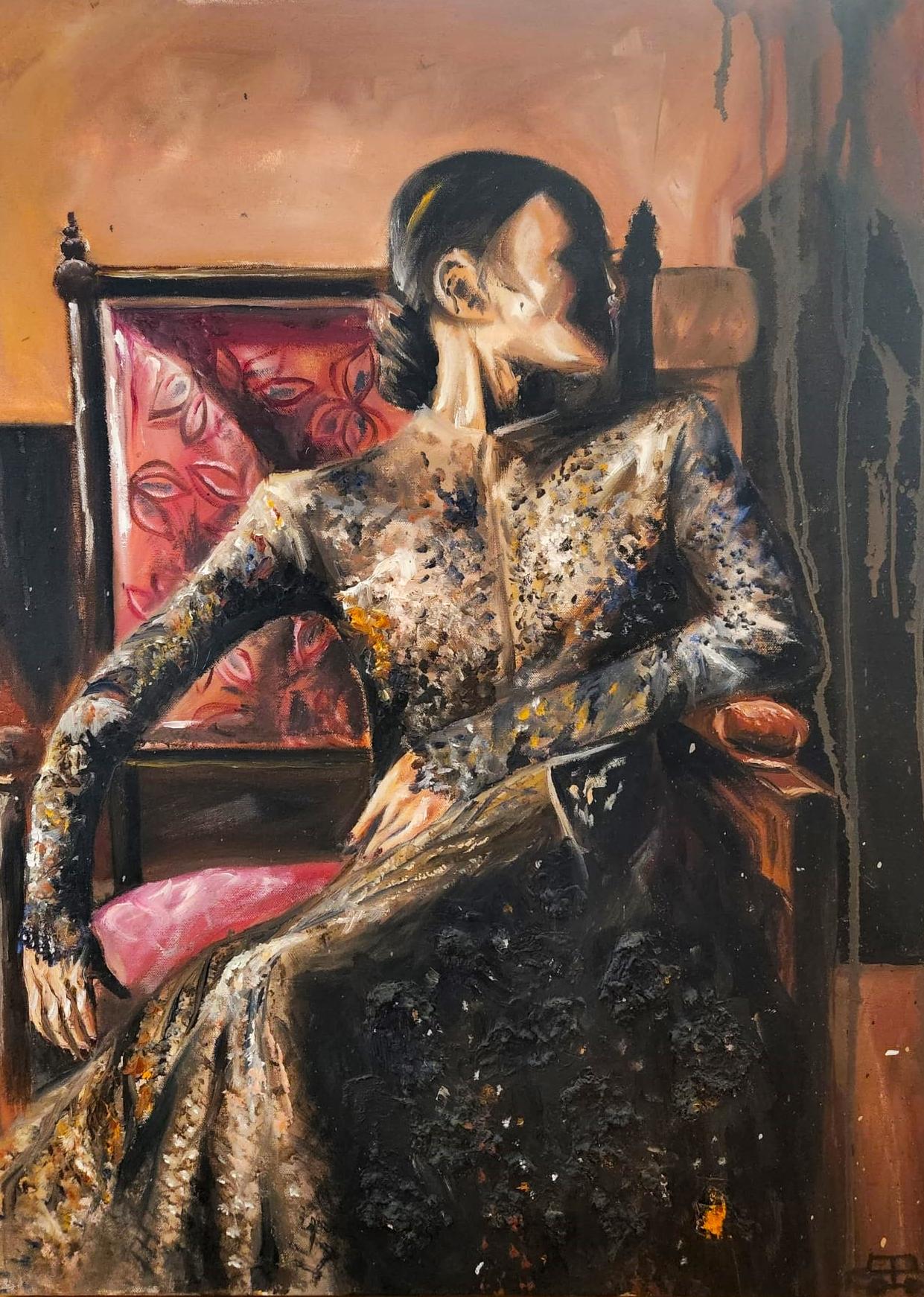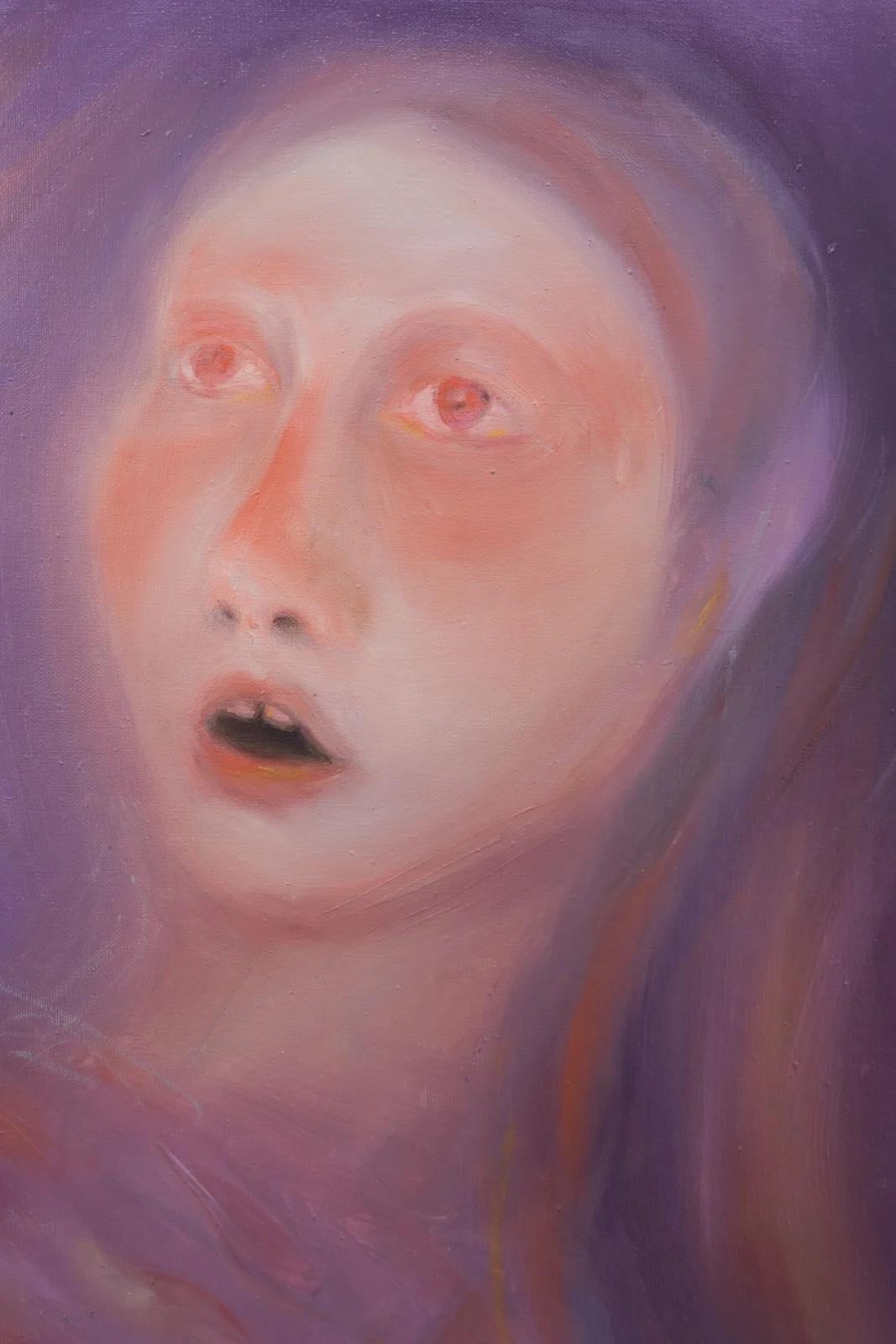Items Similar to "Artist Painting Still Life" Expressionistic Style Oil Painting on Canvas
Want more images or videos?
Request additional images or videos from the seller
1 of 15
Michael Baxte"Artist Painting Still Life" Expressionistic Style Oil Painting on CanvasMid-20th Century
Mid-20th Century
About the Item
A strong modernist oil painting depicted in the Mid Centruy by Russian painter Michael Baxte. Mostly known for his abstracted figures on canvas or street scenes, this piece is a wonderful representation of his interior scenes with expressive use of color, shape, and form. Later in his career, Baxte explores Expressionism, infusing both European and North American stylistic trends.
This painting measures 32 x 25.5 inches
Michael Posner Baxte was born in 1890 in the small town of Staroselje Belarus, Russia. For the first half of the 19th century, it was a center of the Chabad movement of Hasidic Jews, but this group was gone by the middle of the 19th century. By the time the Baxte family immigrated to the United States at the beginning of the 20th century, the Jewish population numbered only on the hundreds. The native language of the Baxte family was Yiddish. It is likely that the death of Michael Baxte’s father triggered the family’s immigration. Three older brothers arrived in New York between 1903 and 1905. Michael and his mother, Rebecca, arrived in 1907. By 1910 Michael, his mother, and brother, Joseph, were living in New Orleans and may have spent some time on a Louisiana plantation. Around 1912, Michael Baxte returned to Europe to study the violin. In 1914 he, his mother, and Joseph moved to New York City.
Meanwhile, in Algeria, a talented young woman painter, Violette Mege, was making history. For the first time, a woman won the prestigious Beaux Art competition in Algeria. At first, the awards committee denied her the prize but, with French government intervention, Mege eventually prevailed. She won again 3 years later and, in 1916, used the scholarship to visit the United States of America. When Violette came to New York, she met Baxte, who was, by then, an accomplished violinist, teacher, and composer. Baxte’s compositions were performed at the Tokyo Imperial Theater, and in 1922 he was listed in the American Jewish Yearbook as one of the prominent members of the American Jewish community. As a music teacher, he encouraged individual expression. Baxte stated, “No pupil should ever be forced into the imitation of the teacher. Art is a personal experience, and the teacher’s truest aim must be to awaken this light of personality through the patient's light of science.”
By 1920 Michael Baxte and Violette Mege were living together in Manhattan. Although they claimed to be living as husband and wife, it seems that their marriage did not become official until 1928. On their “unofficial” honeymoon around 1917, in Algiers, Baxte confided to her his ambition to paint. There and later in New Mexico where the wonderful steeped sunlight approximates the coloring of Algiers, she taught him his heart’s desire. He never had any other teacher. She never had any other pupil. For ten years she devoted all her time, energy, and ambition to teaching, encouraging, inspiring him. Then in 1928, their mutual strivings were rewarded, as his works were being chosen as one of the two winners in the Dudensing National Competition for American Painters. Out of 150 artists from across the country participated in the Dudensing, and Michael Posner Baxte and, Robert Fawcett, were the winners.
In his 1924 naturalization application, he indicated that he was sometimes known as “Michael Posner Baxte.” One of the witnesses to his application was Bernard Karfiol, a Jewish American artist. That’s when Michael may have decided to use the name Baxte for his art. Baxte, née Posner, received critical acclaim from art critics. In 1929, Lloyd Goodrich of The New York Times wrote, “Mr. Baxte has a way of choosing aspects of the world that are quite unhackneyed… He is an artist of considerable subtlety, not too strong perhaps, and sometimes a little uncertain, but always sensitive and interesting. One feels in each of his pictures an absorption in his subject and an individual manner of looking at it. He has a very attractive color sense, warm, sensuous, and unexpected, which seems natural and unforced.” A dozen years later another New York Times art critic, Howard Devree, commented, “Also at the Bonestell are paintings by Michael Baxte, who lays in his color with gusto and considerable acumen.”
During the 1930’s Baxte and his wife, Violet, lived in France and spent most of their time in Paris, where Baxte became part of the School of Paris and exhibited his artwork in government-sponsored exhibitions including the Salon d'Automne, helping as well to organize an exhibition of American painters. When World War II began, and Paris became unsafe Baxte and his wife relocated to Mexico where they continued to live and work. Baxte died in 1972 in Mexico.
PROVENANCE: Private collection; Lilac Gallery Collection. The piece will be stamped from Lilac Gallery on its verso.
- Creator:Michael Baxte (1890 - 1972, Russian)
- Creation Year:Mid-20th Century
- Dimensions:Height: 32 in (81.28 cm)Width: 25.5 in (64.77 cm)Depth: 1 in (2.54 cm)
- Medium:
- Movement & Style:
- Period:
- Framing:Framing Options Available
- Condition:This piece is in excellent condition besides some wear on outer edge of the canvas from age.
- Gallery Location:New York, NY
- Reference Number:
About the Seller
5.0
Platinum Seller
These expertly vetted sellers are 1stDibs' most experienced sellers and are rated highest by our customers.
Established in 2012
1stDibs seller since 2015
1,486 sales on 1stDibs
Typical response time: 1 hour
- ShippingRetrieving quote...Ships From: New York, NY
- Return PolicyA return for this item may be initiated within 7 days of delivery.
More From This SellerView All
- "Mexican Landscape Scene of Mother with Children" Expressionistic Style PaintingBy Michael BaxteLocated in New York, NYA strong modernist oil painting depicted in 1962 by Russian painter Michael Baxte. Mostly known for his abstracted figures on canvas or street scenes, this piece is a wonderful representation of his portraits in countryside landscapes with expressive use of color, shape, and form. Later in his career, Baxte explores Expressionism, infusing both European and North American stylistic trends. Art measures 21.25 x 25.5 inches Michael Posner Baxte was born in 1890 in the small town of Staroselje Belarus, Russia. For the first half of the 19th century, it was a center of the Chabad movement of Hasidic Jews, but this group was gone by the middle of the 19th century. By the time the Baxte family immigrated to the United States at the beginning of the 20th century, the Jewish population numbered only on the hundreds. The native language of the Baxte family was Yiddish. It is likely that the death of Michael Baxte’s father triggered the family’s immigration. Three older brothers arrived in New York between 1903 and 1905. Michael and his mother, Rebecca, arrived in 1907. By 1910 Michael, his mother, and brother, Joseph, were living in New Orleans and may have spent some time on a Louisiana plantation. Around 1912, Michael Baxte returned to Europe to study the violin. In 1914 he, his mother, and Joseph moved to New York City. Meanwhile, in Algeria, a talented young woman painter, Violette Mege, was making history. For the first time, a woman won the prestigious Beaux Art competition in Algeria. At first, the awards committee denied her the prize but, with French government intervention, Mege eventually prevailed. She won again 3 years later and, in 1916, used the scholarship to visit the United States of America. When Violette came to New York, she met Baxte, who was, by then, an accomplished violinist, teacher, and composer. Baxte’s compositions were performed at the Tokyo Imperial Theater, and in 1922 he was listed in the American Jewish Yearbook as one of the prominent members of the American Jewish community. As a music teacher, he encouraged individual expression. Baxte stated, “No pupil should ever be forced into the imitation of the teacher. Art is a personal experience, and the teacher’s truest aim must be to awaken this light of personality through the patient's light of science.” By 1920 Michael Baxte and Violette Mege were living together in Manhattan. Although they claimed to be living as husband and wife, it seems that their marriage did not become official until 1928. On their “unofficial” honeymoon around 1917, in Algiers, Baxte confided to her his ambition to paint. There and later in New Mexico where the wonderful steeped sunlight approximates the coloring of Algiers, she taught him his heart’s desire. He never had any other teacher. She never had any other pupil. For ten years she devoted all her time, energy, and ambition to teaching, encouraging, inspiring him. Then in 1928, their mutual strivings were rewarded, as his works were being chosen as one of the two winners in the Dudensing National Competition for American Painters. Out of 150 artists from across the country participated in the Dudensing, and Michael Posner Baxte and, Robert Fawcett...Category
1960s Expressionist Figurative Paintings
MaterialsOil, Masonite
- "Mexican Villagers Scene with Man on a Horse" Expressionistic Style Oil PaintingBy Michael BaxteLocated in New York, NYA strong modernist oil painting depicted in the Mid Century by Russian painter Michael Baxte. Mostly known for his abstracted figures on canvas or street scenes, this piece is a wonderful representation of his portraits in village landscapes with expressive use of color, shape, and form. Later in his career, Baxte explores Expressionism, infusing both European and North American stylistic trends. Art measures 25.5 x 21.25 inches Michael Posner Baxte was born in 1890 in the small town of Staroselje Belarus, Russia. For the first half of the 19th century, it was a center of the Chabad movement of Hasidic Jews, but this group was gone by the middle of the 19th century. By the time the Baxte family immigrated to the United States at the beginning of the 20th century, the Jewish population numbered only on the hundreds. The native language of the Baxte family was Yiddish. It is likely that the death of Michael Baxte’s father triggered the family’s immigration. Three older brothers arrived in New York between 1903 and 1905. Michael and his mother, Rebecca, arrived in 1907. By 1910 Michael, his mother, and brother, Joseph, were living in New Orleans and may have spent some time on a Louisiana plantation. Around 1912, Michael Baxte returned to Europe to study the violin. In 1914 he, his mother, and Joseph moved to New York City. Meanwhile, in Algeria, a talented young woman painter, Violette Mege, was making history. For the first time, a woman won the prestigious Beaux Art competition in Algeria. At first, the awards committee denied her the prize but, with French government intervention, Mege eventually prevailed. She won again 3 years later and, in 1916, used the scholarship to visit the United States of America. When Violette came to New York, she met Baxte, who was, by then, an accomplished violinist, teacher, and composer. Baxte’s compositions were performed at the Tokyo Imperial Theater, and in 1922 he was listed in the American Jewish Yearbook as one of the prominent members of the American Jewish community. As a music teacher, he encouraged individual expression. Baxte stated, “No pupil should ever be forced into the imitation of the teacher. Art is a personal experience, and the teacher’s truest aim must be to awaken this light of personality through the patient's light of science.” By 1920 Michael Baxte and Violette Mege were living together in Manhattan. Although they claimed to be living as husband and wife, it seems that their marriage did not become official until 1928. On their “unofficial” honeymoon around 1917, in Algiers, Baxte confided to her his ambition to paint. There and later in New Mexico where the wonderful steeped sunlight approximates the coloring of Algiers, she taught him his heart’s desire. He never had any other teacher. She never had any other pupil. For ten years she devoted all her time, energy, and ambition to teaching, encouraging, inspiring him. Then in 1928, their mutual strivings were rewarded, as his works were being chosen as one of the two winners in the Dudensing National Competition for American Painters. Out of 150 artists from across the country participated in the Dudensing, and Michael Posner Baxte and, Robert Fawcett...Category
Mid-20th Century Expressionist Figurative Paintings
MaterialsMasonite, Oil
- "Landscape Scene of Mexican Villagers" Expressionistic Oil Painting on MasoniteBy Michael BaxteLocated in New York, NYA strong modernist oil painting depicted in 1971 by Russian painter Michael Baxte. Mostly known for his abstracted figures on canvas or street scenes, this piece is a wonderful representation of his landscape paintings, with expressive use of color, shape, and form. Later in his career, Baxte explores Expressionism, infusing both European and North American stylistic trends. This piece is from later in his career, but we can feel this underlying style throughout. Art measures 18 x 21.75 inches Michael Posner Baxte was born in 1890 in the small town of Staroselje Belarus, Russia. For the first half of the 19th century it was a center of the Chabad movement of Hasidic Jews, but this group was gone by the middle of the 19th century. By the time the Baxte family immigrated to the United States at the beginning of the 20th century, the Jewish population numbered only on the hundreds. The native language of the Baxte family was Yiddish. It is likely that the death of Michael Baxte’s father triggered the family’s immigration. Three older brothers arrived in New York between 1903 and 1905. Michael and his mother, Rebecca, arrived in 1907. By 1910 Michael, his mother, and brother, Joseph, were living in New Orleans and may have spent some time on a Louisiana plantation. Around 1912, Michael Baxte returned to Europe to study the violin. In 1914 he, his mother, and Joseph moved to New York City. Meanwhile, in Algeria, a talented young woman painter, Violette Mege, was making history. Since for the first time, a woman won the prestigious Beaux Art competition in Algeria. At first, the awards committee denied her the prize but, with French government intervention, Mege eventually prevailed. She won again 3 years later and, in 1916, used the scholarship to visit the United States of America. When Violette came to New York, she met Baxte, who was, by then, an accomplished violinist, teacher, and composer. Baxte’s compositions were performed at the Tokyo Imperial Theater, and in 1922 he was listed in the American Jewish Yearbook as one of the prominent members of the American Jewish community. As a music teacher he encouraged individual expression. Baxte stated, “No pupil should ever be forced into imitation of the teacher. Art is a personal experience, and the teacher’s truest aim must be to awaken this light of personality through the patient light of science.” By 1920 Michael Baxte and Violette Mege were living together in Manhattan. Although they claimed to be living as husband and wife, it seems that their marriage did not become official until 1928. On their “unofficial” honeymoon around 1917, in Algiers, Baxte confided to her his ambition to paint. There and later in New Mexico where the wonderful steeped sunlight approximates the coloring of Algiers, she taught him his heart’s desire. He never had any other teacher. She never had any other pupil. For ten years she devoted all her time, energy, and ambition to teaching, encouraging, inspiring him. Then in 1928, their mutual strivings were rewarded, as his works were being chosen as one of the two winners in the Dudensing National Competition for American Painters. Out of 150 artists from across the country participated in the Dudensing, and Michael Posner Baxte and, Robert Fawcett, were the winners. In his 1924 naturalization application, he indicated that he was sometimes known as “Michael Posner Baxte.” One of the witnesses to his application was Bernard Karfiol, a Jewish American artist. That’s when Michael may...Category
1960s Expressionist Landscape Paintings
MaterialsMasonite, Oil
- "Mexican Outdoor Scene with Figures" Expressionistic Style Oil Painting on BoardBy Michael BaxteLocated in New York, NYA strong modernist oil painting depicted in the Mid Century by Russian painter Michael Baxte. Mostly known for his abstracted figures on canvas or street scenes, this piece is a wond...Category
1960s Expressionist Landscape Paintings
MaterialsOil, Masonite
- "Pescadores" Expressionistic Style Mexican Scene by the Water with FishermenBy Michael BaxteLocated in New York, NYA strong modernist oil painting depicted in the Mid Century by Russian painter Michael Baxte. Mostly known for his abstracted figures on canvas or street scenes, this piece is a wond...Category
1950s Expressionist Landscape Paintings
MaterialsOil, Masonite
- "Mexican Interior Scene Scene with Figures and Fish" Expressionistic StyleBy Michael BaxteLocated in New York, NYA strong modernist oil painting depicted in the Mid Century by Russian painter Michael Baxte. Mostly known for his abstracted figures on canvas or street scenes, this piece is a wond...Category
1950s Expressionist Portrait Paintings
MaterialsOil, Masonite
You May Also Like
- The New WifeLocated in Brooklyn, NYThe painting is an oil on canvas, measuring 48" x 36". The painting is multilayered to show skin texture, and source of light. The painting shows a young woman fixing her shawl, an a...Category
2010s Expressionist Figurative Paintings
MaterialsCanvas, Oil
- Bargain AuntyLocated in Brooklyn, NYThe painting is an oil on canvas, measuring 45" x 33". There is a lot of texture on this painting created by cigarette butts and ash mixed with oil paint, smeared on the canvas to highlight the hair. The painting shows a character inspired by Bollywood, in the market, reflecting on all the patterns and designs she sees in a South Asian jewelry...Category
2010s Expressionist Portrait Paintings
MaterialsOil, Canvas
- Missed CallLocated in Brooklyn, NYThis painting is an oil on canvas measuring 36" x 29". Portrait was stylized on artist owned images. Framing is available based on buyers preference. The image depicts a middle aged...Category
21st Century and Contemporary Expressionist Portrait Paintings
MaterialsCanvas, Oil
- The GameLocated in Brooklyn, NYPainting is an oil on canvas, measuring 30" x 22". There is a lot of texture on this painting built up entirely of scraped and dried oil paint. This image is a dark one, showing a wo...Category
2010s Expressionist Figurative Paintings
MaterialsCanvas, Oil
- DenseLocated in Brooklyn, NYThe painting is about a woman stuck still in time, statuesque and hard looking. The are many layers of strokes to build on the hardness of the figure...Category
21st Century and Contemporary Expressionist Portrait Paintings
MaterialsCanvas, Oil
- Fire Ball by Anna Taganzeva-Kobzeva - Painting, oil on canvas, 2023Located in Basel, BSThe painting Fire Ball by contemporary artist Anna Taganzeva-Kobzeva was shown at the group exhibition "Floral & Machine" at St. Paulus Church in Basel in 2023. The exhibition delves...Category
2010s Expressionist Figurative Paintings
MaterialsCanvas, Oil
Recently Viewed
View AllMore Ways To Browse
1920s Style Paintings
Michael Mayer
French Country Style Painting
List All Mexican Artists
Old Mexico Paintings
Mexican American Oil On Canvas
1920s Paris France Paintings
Old Russian Painting
France Oil Painting 3 X 3
Oil Painting Native American Style
32 Inch Oil Painting
French Oil Painting 1890
Jewish Russian Painting
19th Century Russian Painting
Russian 20th Century Oil
19th Century Russian Artist
Painting Mexican Town
Composer Painting
